This is getting a little boring, the trend is clear except for weeks when DOH clearly screws up. Around 70% of cases, around 65% of hospitalizations and the great majority of deaths, this week 11 of 13, are in the vaxed or vaxed and boosted. I see no reason why that will change, might get worse. And those case and hospital proportions are close to the proportion of people vaxed in the state. If we could account for home testing and incidentals, I suspect the proportion of cases in the vaxed and vaxed and boosted would be even higher, but the proportion of hospitalizations lower. Let me add once more, my greatest appreciation for the constant excellent work Dave Dixon does in analyzing the data and putting these charts together.
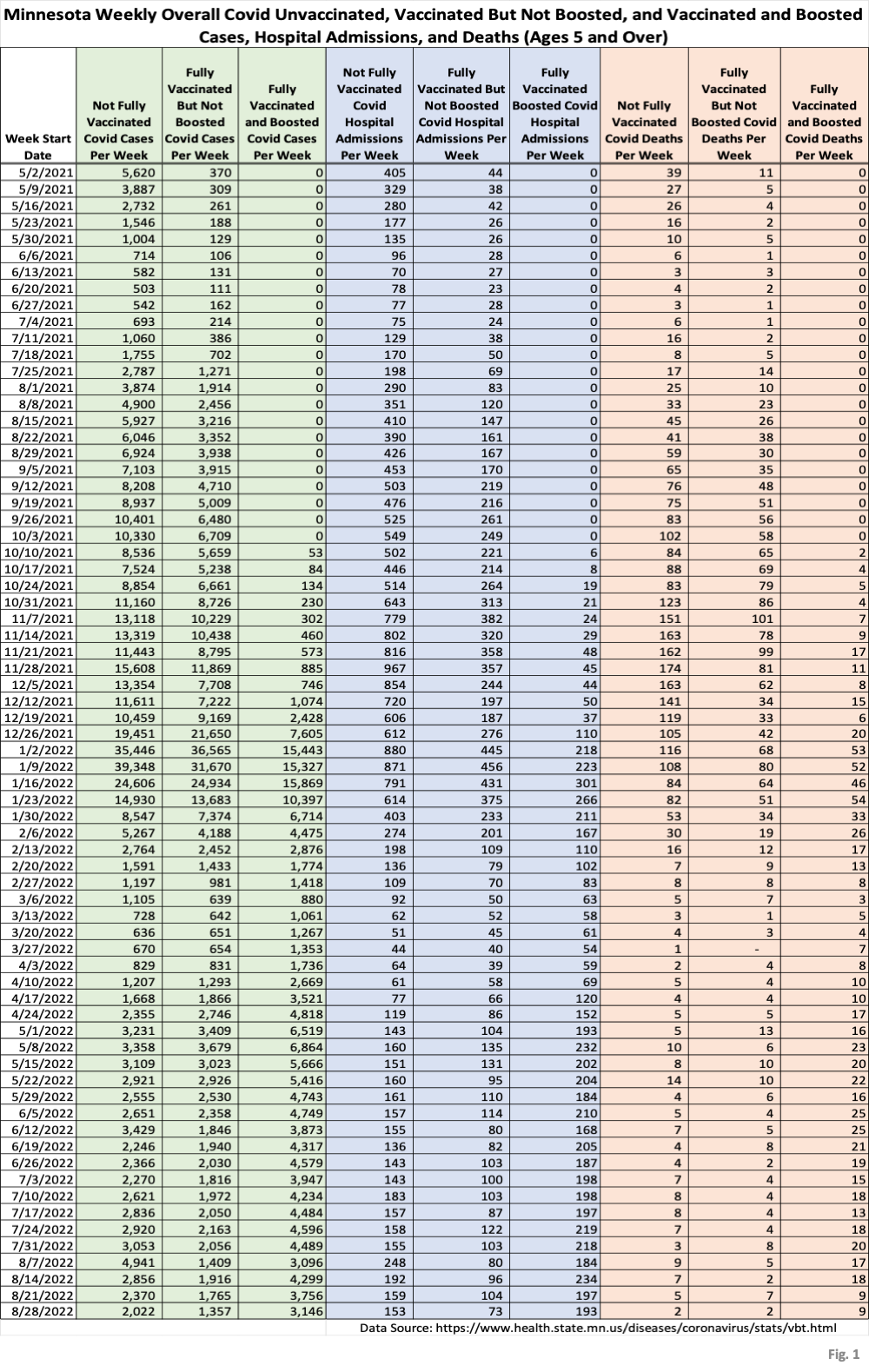

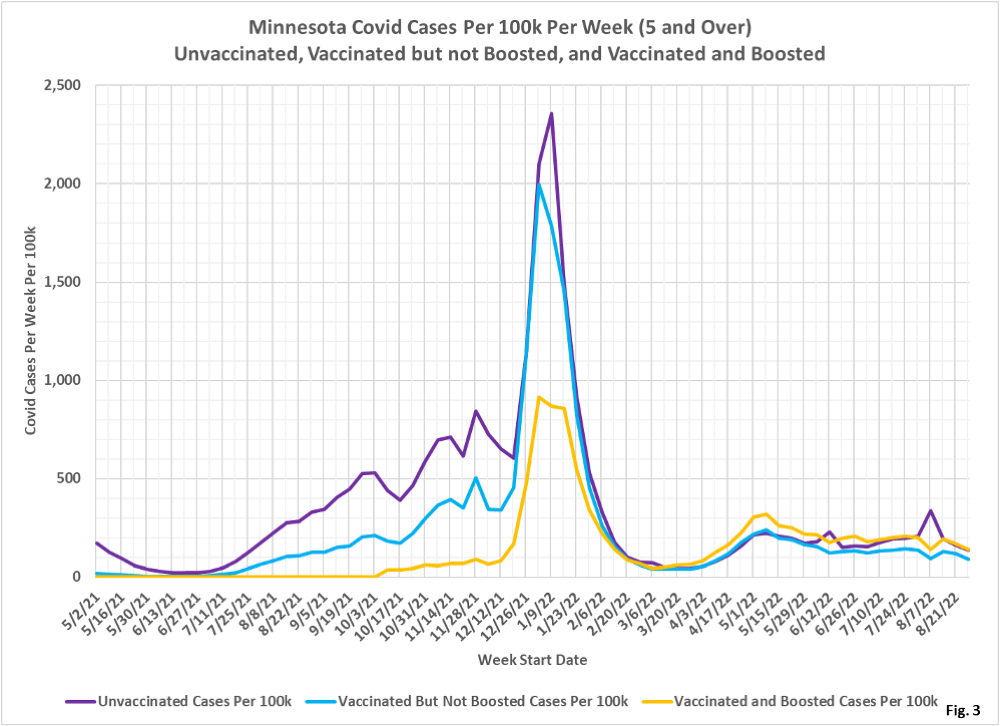
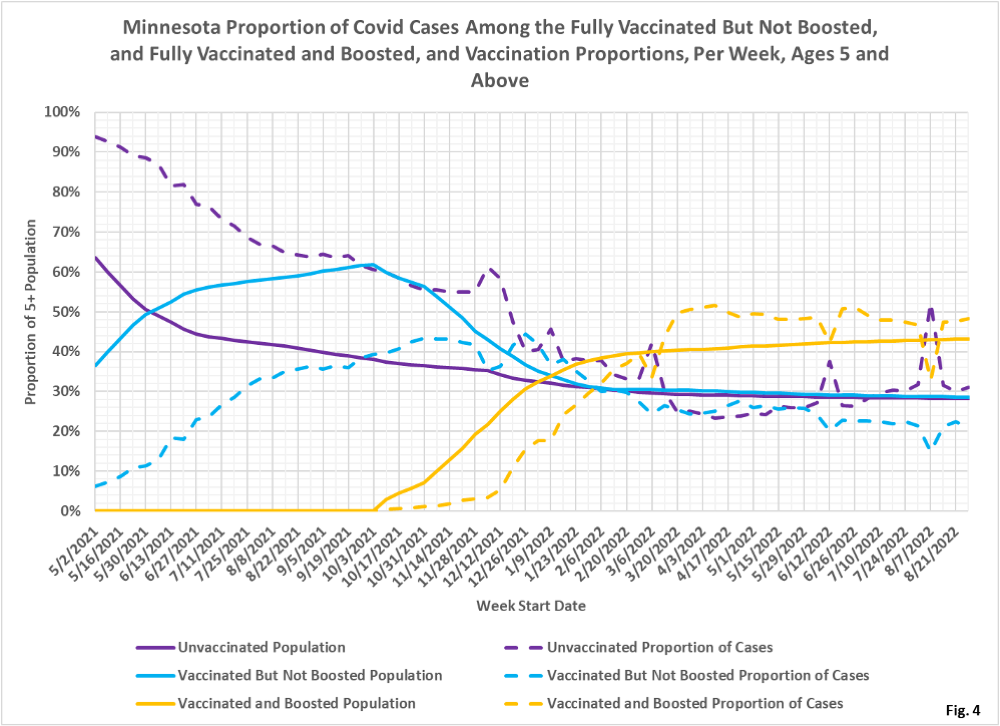
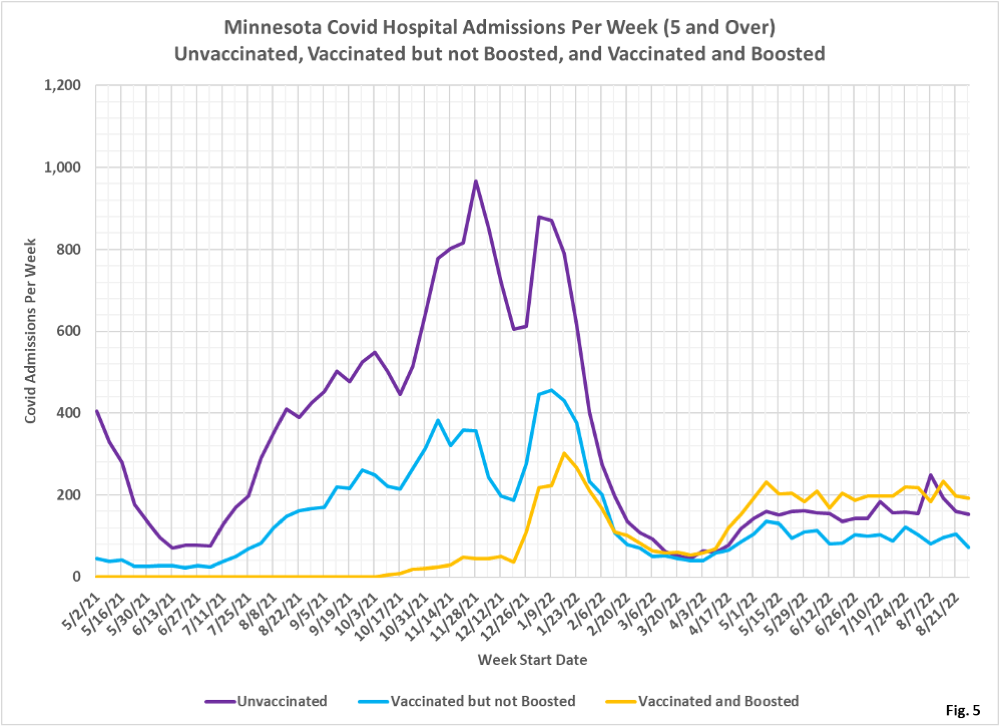

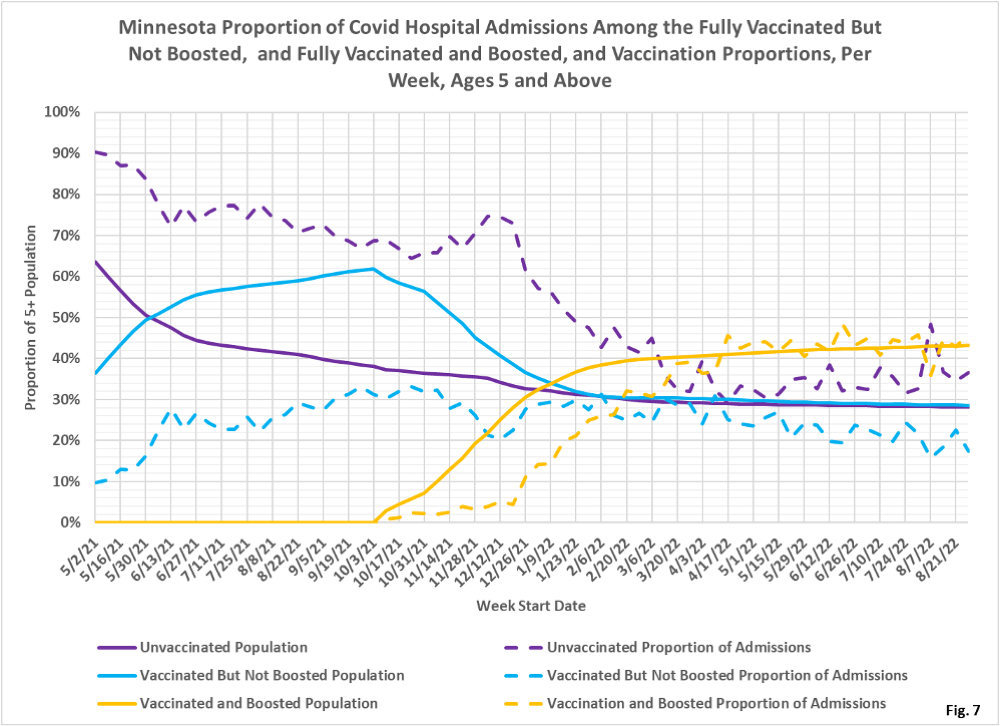
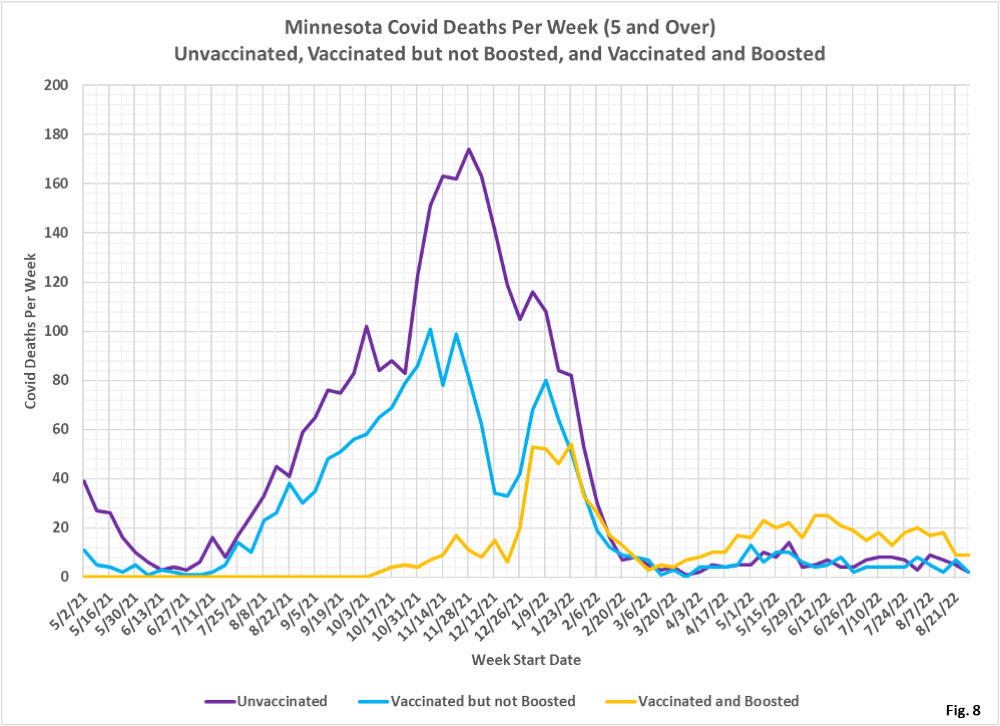
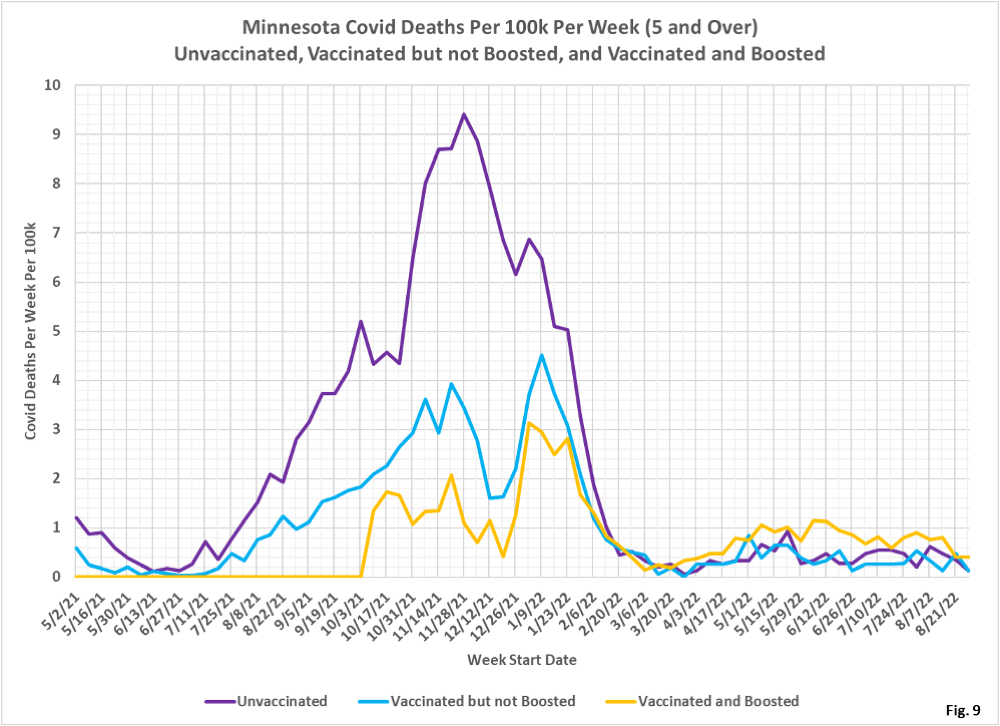
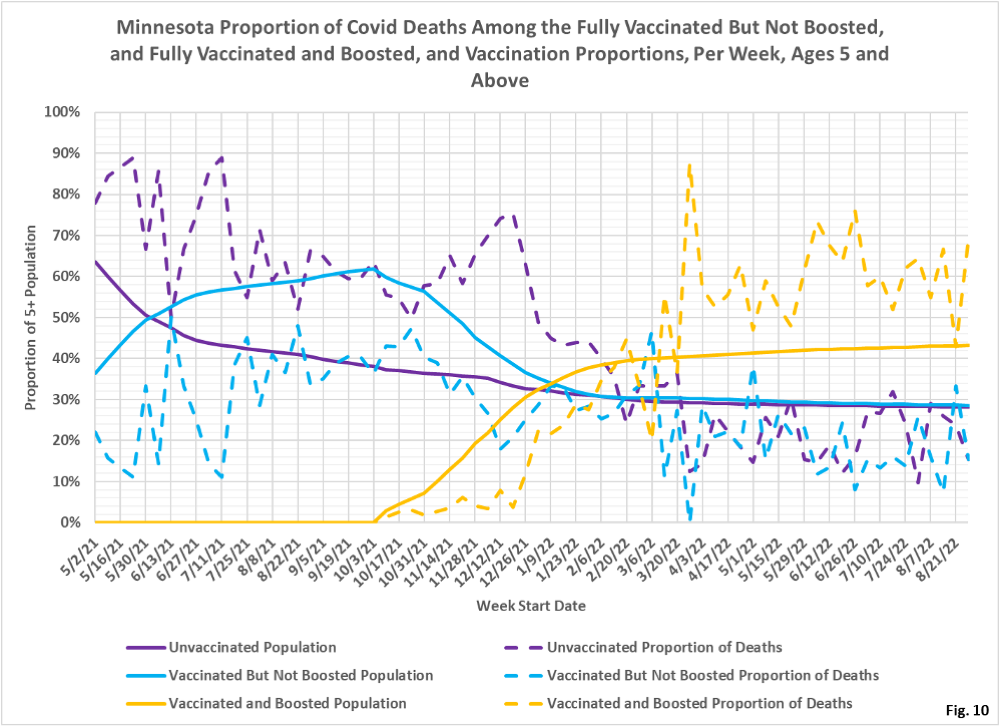
Dave’s notes:
- We noted a peculiar spike in unvaccinated cases and hospital admissions in the data released three weeks ago on 9/01/2022. This was accompanied by a decrease in vaccinated, and boosted, hospital admissions. In the new data released since then the cases and hospital admissions have generally returned to the prior trends. We note also that a similar, but slightly smaller, discontinuity in cases for the week of 6/12/2022, and this discontinuity has not been revised in the intervening weeks. The spike in unvaccinated cases and hospital admissions has not been revised in the slightest in the last three weeks of new data that has been released by the Minnesota Department of Health (MDH).
- This post is an update to the breakthrough data table and charts for the overall Minnesota population published on 9/17/22 here: https://healthy-skeptic.com/
2022/09/17/breakthrough- events-september-15/. This week’s update adds data for the week ending 8/28/2022, newly published by MDH on 9/22/2022. As is usual, there are very minor updates to prior weeks as well. - The breakthrough data files are available from MDH here, https://www.health.state.mn.
us/diseases/coronavirus/stats/ vbt.html , in the notes under the graphic images. - The charts in Fig. 2 through 10 contain 3 charts for each type of event (cases, admissions, or deaths). The first chart for each type is the number of events each week, illustrating in raw numbers the overall trend on the pandemic for the overall population, and the impact on resource use of each sub-group. The second chart is the rate of events per 100k each week, displaying the risk to an individual of each category at different times during the pandemic. The third chart for each type of event is the proportion of event compared to the proportion of the population type (unvaccinated, vaccinated, or boosted). This chart helps show whether or not vaccination or boosting is effective in reducing the impact of the pandemic, by comparing the proportion of events to the proportion of the population.
- Fig. 1: This table displays the total cases, hospital admissions, and deaths that occurred each week among the unvaccinated, vaccinated but not boosted, and vaccinated and boosted populations. The week of 8/28/2022 has been added this week. In the three new weeks of data since the anomalous spike in unvaccinated cases 8/7/2022 there had been a declining trend in cases in all three subgroups.
- Fig. 2: This chart simply plots the cases among the unvaccinated, vaccinated but not boosted, and vaccinated and boosted populations each week, as found in Fig. 1. Note that in the last three weeks the boosted have a slightly higher likelihood of testing positive compared to the unvaccinated, and the vaccinated but not boosted have the lowest positive rate of all. Of course, we do not know the proportions of those who also had a prior infection which could affect both vaccination and boosting rates as well as positivity rates.
- Fig. 3: This chart displays the case rates per 100k for each group. We can see a sharp increase in the unvaccinated case rate for the week of 8/07/2022, and now the reversal for the weeks of 8/14/2022, 8/21/2022 and 8/28/2022. Note also a similar spike which has not been corrected for the week of 6/12/2022. The prevailing trend since early July has been for the boosted and unvaccinated case rate to be almost identical, and for the vaccinated but not boosted case rate to be somewhat lower. It is not immediately obvious why the vaccinated but not boosted should have a lower case rate.
- Fig. 4: This chart displays the proportion of the 5 and over population who are unvaccinated (solid purple), vaccinated but not boosted (solid blue), and vaccinated and boosted (solid gold). For each population group we also display the proportion of cases each week (dashed lines of same color). The way to interpret this chart is to compare the proportion of breakthroughs to the proportion of vaccinations for each group. Whenever the dashed breakthrough proportion line is below the solid vaccination line of the same color, then that category is underrepresented for population, and when the dashed line is above the solid line of the same color then that category is overrepresented. For the week of 8/28/22 the boosted made up 43% of the overall population but accounted for 48% of the cases, while the vaccinated but not boosted made up 29% of the population but only accounted for 21% of the cases. The unvaccinated accounted for 29% of the population and accounted for 31% of the population.
- Fig. 5-7: These charts display the hospital admissions, hospital admission rates per 100k, and hospital admissions proportions for the 5+ age group, in an identical format to the case charts in Fig. 2 through Fig. 4. Fig. 5 shows less of a decline in admissions than cases do in Fig. 2, ignoring the spike in unvaccinated admissions on 8/7/2022 which we believe is a data anomaly. For several months the boosted have made up the largest portion of admissions, and therefore have created the most burden on hospitals. Fig. 6 shows the unvaccinated consistently have the highest hospitalization rate in recent weeks, followed by the boosted, and the vaccinated but not boosted having the lowest hospitalization rate. Fig. 7 shows that the unvaccinated made up 29% of the population the week of 8/28/2022 but account for 37% of the admissions, while the vaccinated but not boosted made up for 29% of the population but only accounted for 17% of the admissions.
- Fig. 8-10: These charts display the deaths, deaths rates per 100k, and deaths proportions for the 5+ age group, in an identical format to the case charts in Fig. 2 through Fig. 4. There have been more deaths every week among the boosted for several months, and this trend continues the week of 8/28/2022 (Fig. 8). The death rates per 100k are all very low for the week of 8/28/2022, but the boosted continue to have a higher death rate, skewed by higher booster rates in the elderly (Fig. 9). For the week of 8/28/2022, the boosted make up 43% of the overall population but account for 69% of the weekly deaths, while the unvaccinated make up 29% of the population but account for only 15% of the deaths (Fig. 10).
- MDH defines the fully vaccinated (what we have termed vaccinated but not boosted) as those who have not received a booster after completing their primary vaccination series, and had been vaccinated at least 14 days prior to testing positive.
- MDH defines the boosted as those who have received any additional vaccination shots after completing their primary vaccination series, and also received the booster at least 14 days prior to testing positive. In addition, booster doses were only counted after 8/13/2021, the date the CDC first began recommending booster shots.


On the topic of breakthrough events can we tell if stratified by age and vaccine status there is an advantage for boosted adults over 60. I whole heartedly agree that healthy individuals under 60 especially under 20 do not need boosters.
should have age specific charts up shortly, and yes, especially in regard to hospitalization there is clear benefit from vax
Kevin, thanks for all the hard work. I’m wondering how to monitor the uptake of the new boosters, and whether there are issues making them at all counterproductive. Esp. with someone 75+ having had Covid over the summer, in spite of full VAX/boost.
I personally am done with boosters. i doubt they will help much in someone who is already boosted and has had CV-19. They don’t appear to have any longer lasting protection against infection than did the original doses. As always, consult with a physician, but I don’t know why people would take multiple boosters.